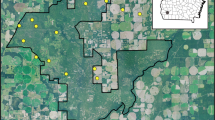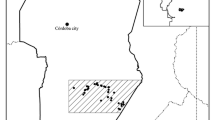Abstract
With the loss of natural wetlands, artificial wetlands are becoming increasingly important as habitat for waterbirds. We investigated the relationships between waterbirds and various biophysical parameters on artificial wetlands in an Australian urban valley. The densities (birds per hectare) of several species were correlated (mostly positively) with wetland area, and correlations were observed between certain species and other physical and water chemistry variables. Waterbird community structure, based on both abundance (birds per wetland) and density data, was most consistently positively correlated with the relative amount of wetland perimeter that was vegetated, surface area, distance to nearest wetland, public accessibility and shoreline irregularity. We also compared the relative use of the two types of urban wetlands, namely urban lakes and stormwater treatment wetlands, and found for both abundance and density that the number of individuals and species did not vary significantly between wetland types but that significant differences were observed for particular species and feeding guilds, with no species or guild being more abundant or found in greater density on an urban lake than a stormwater treatment wetland. Designing wetlands to provide a diversity of habitat will benefit most species.

Similar content being viewed by others
References
Anderson, M. J., 2001. A new method for non parametric multivariate analysis of variance. Austral Ecology 26: 32–46.
Anderson, M. J., R. N. Gorley & K. R. Clarke, 2008. PERMANOVA+ for PRIMER. Guide to software and statistical methods PRIMER-E Ltd, Plymouth, UK.
APHA, AWWA & WEF, 2005. Standard Methods for the Examination of Water and Wastewater, 21st edn. American Public Health Association, Washington, DC.
Bregnballe, T., C. Speich, A. Horsten & A. D. Fox, 2009. An experimental study of numerical and behavioural responses of spring staging dabbling ducks to human pedestrian disturbance. Wildfowl (special issue 2): 131–142.
Campbell, D. A., C. A. Cole & R. P. Brooks, 2002. A comparison of created and natural wetlands in Pennsylvania, USA. Wetlands Ecology and Management 10: 41–49.
Clarke, K. R. & M. Ainsworth, 1993. A method of linking multivariate community structure to environmental variables. Marine Ecology Progress Series 92: 205–219.
Clarke, K. R. & R. N. Gorley, 2006. PRIMER v6: User Manual/Tutorial PRIMER-E, Plymouth, UK.
Corrick, A. H. & F. I. Norman, 1980. Wetlands of Victoria 1. Wetlands and waterbirds of the Snowy River and Gippsland Lakes catchments. Proceedings of the Royal Society of Victoria 91: 1–15.
Craft, C. B., 1997. Dynamics of nitrogen and phosphorus retention during wetland ecosystem succession. Wetlands Ecology and Management 4: 177–187.
Danger, A. & C. J. Walsh, 2008. Management options for conserving and restoring fauna and other ecological values of urban streams in the Melbourne Water region. A Report to the Melbourne Water.
Favaloro, N., 1944. Notes on the two resident Victorian plovers. Emu 43: 145–153.
Fjeldså, J., 1985. Classification of waterbird communities in south-eastern Australia. Emu 85: 141–149.
Frith, H. J., L. W. Braithwaite & J. L. McKean, 1969. Waterfowl in an inland swamp in New South Wales. 2. Food. Wildlife Research 14: 17–64.
Froneman, A., M. J. Mangnall, R. M. Little & T. M. Crowe, 2001. Waterbird assemblages and associated habitat characteristics of farm ponds in the Western Cape, South Africa. Biodiversity and Conservation 10: 251–270.
Haig, S. M., D. W. Mehlman & L. W. Oring, 1998. Avian movements and wetland connectivity in landscape conservation. Conservation Biology 12: 749–758.
Halse, S. A., M. R. Williams, R. P. Jaensch & J. A. K. Lane, 1993. Wetland characteristics and waterbird use of wetlands in south-western Australia. Wildlife Research 20: 103–125.
Hamilton, A. J., I. R. Taylor & G. Hepworth, 2002. Activity budgets of waterfowl (Anatidae) on a waste stabilisation pond. Emu 102: 171–179.
Hamilton, A. J., I. R. Taylor & P. M. Rogers, 2004. Seasonal and diurnal patterns in abundance of waterbirds at a waste-stabilisation pond in Victoria. Corella 28: 43–54.
Hansson, L. A., C. Bronmark, P. Anders Nilsson & K. Abjornsson, 2005. Conflicting demands on wetland ecosystem services: nutrient retention, biodiversity or both? Freshwater Biology 50: 705–714.
Hartke, K. M., K. H. Kriegel, G. M. Nelson & M. T. Merendino, 2009. Abundance of wigeongrass during winter and use by herbivorous waterbirds in a Texas coastal marsh. Wetlands 29: 288–293.
Hattori, A. & S. Mae, 2001. Habitat use and diversity of waterbirds in a coastal lagoon around Lake Biwa, Japan. Ecological Research 16: 543–553.
Kelly, J. P., D. Stralberg, K. Etienne & M. McCaustland, 2008. Landscape influence on the quality of heron and egret colony sites. Wetlands 28: 257–275.
Kersten, M., R. H. Britton, P. J. Dugan & H. Hafner, 1991. Flock feeding and food intake in little egrets: the effects of prey distribution and behaviour. The Journal of Animal Ecology 60: 241–252.
Kingsford, R. T., 1989. Food of the Maned Duck Chenonetta jubata during the Breeding Season. Emu 89: 119–124.
Kingsford, R. T. & F. I. Norman, 2002. Australian waterbirds—products of the continent’s ecology. Emu 102: 47–69.
Kingsford, R. T., K. J. Brandis, K. M. Jenkins, L. C. Nairn & T. A. Raynor, 2010. Measuring ecosystem responses to flow across temporal and spatial scales. In Saintilan, N. & I. Overton (eds), Ecosystem response modelling in the Murray-Darling Basin. CSIRO, Melbourne: 15–35.
Lowe, K. W., 1983. Feeding behaviour and diet of the White-faced Heron Ardea novaehollandiae in Westernport Bay, Victoria. Corella 7: 101–108.
Loyn, R. H., 1989. The Management of Duck Hunting in Victoria: A Review. Technical Report 70. Arthur Rylah Institute for Environmental Research, Melbourne.
Loyn, R. H., P. Dann & P. Bingham, 1994. Ten years of waterbird counts in Westernport Bay, Victoria, 1973–1983. I Waterfowl and large wading birds. Australian Bird Watcher 15: 333–350.
Ma, Z., Y. Cai, B. Li & J. Chen, 2010. Managing wetland habitats for waterbirds: an international perspective. Wetlands 30: 15–27.
Marchant, S. & P. J. Higgins, 1990. Handbook of Australian, New Zealand & Antarctic birds, Vol. 1. Ratites to ducks. Oxford University Press, Melbourne.
Marchant, S. & P. J. Higgins, 1993. Handbook of Australian, New Zealand and Antarctic Birds, Vol. 2. Raptors to lapwings. Oxford University Press, Melbourne.
Melbourne Water, 2013. Our stormwater quality wetlands [available on internet at http://www.melbournewater.com.au/content/rivers_and_creeks/the_rivers_and_creeks_system/our_stormwater_quality_wetlands/our_stormwater_quality_wetlands.asp?bhcp=1]. Accessed 2 April 2013.
Murray, C. G. & A. J. Hamilton, 2010. Perspectives on wastewater treatment wetlands and waterbird conservation. Journal of Applied Ecology 47: 976–985.
Murray, C. G., R. H. Loyn, S. Kasel, G. Hepworth, K. Stamation & A. J. Hamilton, 2012. What can a 22-year database tell us about the use of different types of wetlands by waterfowl in south-eastern Australian summers? Emu 112: 209–217.
Navedo, J. G., J. A. Masero, J. M. Sanchez-Guzman, J. M. Abad-Gomez, J. S. Gutierrez, E. G. Sanson, A. Villegas, E. Costillo, C. Corbacho & R. Moran, 2012. International importance of Extremadura, Spain, for overwintering migratory dabbling ducks: a role for reservoirs. Bird Conservation International 22: 316–327.
Norman, F. I. & L. Mumford, 1985. Studies on the purple swamphen, Porphyrio porphyrio. Victoria Australian Wildlife Research 12: 263–278.
Patterson, H. D. & R. Thompson, 1971. Recovery of inter-block information when block sizes are unequal. Biometrika 58(3): 545–554.
Powell, G. V. N., 1987. Habitat use by wading birds in a subtropical estuary: implications of hydrography. The Auk 104: 740–749.
Rehfisch, M. M., 1994. Man-made lagoons and how their attractiveness to waders might be increased by manipulating the biomass of an insect benthos. Journal of Applied Ecology 31: 383–401.
Russi D., P. Brink ten, A. Farmer, T. Badura, D. Coates, J. Förster, R. Kumar & N. Davidson, 2013. The economics of ecosystems and biodiversity for water and wetlands. IEEP, London and Brussels; Ramsar Secretariat, Gland.
Sanchez-Zapata, J. A., J. D. Anadon, M. Carrete, A. Gimenez, J. Navarro, C. Villacorta & F. Botella, 2005. Breeding waterbirds in relation to artificial pond attributes: implications for the design of irrigation facilities. Biodiversity and Conservation 14: 1627–1639.
Scholz, M. & B. Lee, 2005. Constructed wetlands: a review. International Journal of Environmental Studies 62: 421–447.
Sharma, K. K. & M. Saini, 2012. Impact of anthropogenic pressure on habitat utilization by the waterbirds in Gharana Wetland (reserve), Jammu (J&K, India). International Journal of Environmental Sciences 2: 2050–2062.
Smith, G. C. & N. Carlile, 1993. Methods for population control within a silver gull colony. Wildlife Research 20: 219–225.
Taft, O. W. & S. M. Haig, 2005. The value of agricultural wetlands as invertebrate resources for wintering shorebirds. Agriculture, Ecosystems & Environment 110: 249–256.
Ury, H. K., 1976. A comparision of four procedures for multiple comparisons among means (pairwise contrasts) for arbitary sample sizes. Technometrices 18: 89–97.
Walsh, C. J. & J. Kunapo, 2009. The importance of upland flow paths in determining urban effects on stream ecosystems. Journal of the North American Benthological Society 28: 977–990.
Walsh, C. J., T. D. Fletcher & A. R. Ladson, 2005. Stream restoration in urban catchments through redesigning stormwater systems: looking to the catchment to save the stream. Journal of the North American Benthological Society 24: 690–705.
White, C. L. & M. Main, 2005. Waterbird use of created wetlands in golf-course landscapes. Wildlife Society Bulletin 33: 411–421.
Zedler, J. B., 2000. Progress in wetland restoration ecology. Trends in Ecology and Evolution 15: 402–407.
Acknowledgments
William Steele’s initial suggestions for locating the wetlands used in this study and his instigation of the funding by Melbourne Water for the water chemistry analysis are gratefully acknowledged. We also thank Brad Snibson (Ecowise Australia) for his assistance with the water chemistry analyses and Kumar Eliezer (Principal Biologist, Ecowise Australia) for identifying all of the algae to genus level. Anne Michelson and John Ride provided invaluable support during the field work. We thank David Johns for making the Infomap system available and thank Chandra Jayasuriya for assistance with Fig. 1. We thank two anonymous reviewers for comments that improved the manuscript.
Author information
Authors and Affiliations
Corresponding author
Additional information
Handling editor: Stuart Anthony Halse
Electronic supplementary material
Below is the link to the electronic supplementary material.
Rights and permissions
About this article
Cite this article
Murray, C.G., Kasel, S., Loyn, R.H. et al. Waterbird use of artificial wetlands in an Australian urban landscape. Hydrobiologia 716, 131–146 (2013). https://doi.org/10.1007/s10750-013-1558-x
Received:
Revised:
Accepted:
Published:
Issue Date:
DOI: https://doi.org/10.1007/s10750-013-1558-x




